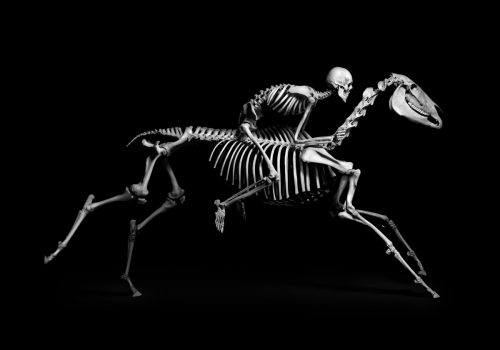The publisher Xavier Barral who passed away 10 days ago, assisted by the writer Jean-Baptiste de Panafieu and photographer Patrick Gries, has designed a book dedicated to the skeletons of animals. From reptiles to birds, a visual menagerie to contemplate at the moment at the Museum of Prehistory of Ile-de-France in Nemours.
At the entrance of the exhibition, a video retraces the astonishing and harrowing epic that constituted the series of photographs that populate the book “Evolution” and the walls of the eponymous exhibition in Nemours. We see the photographer Patrick Gries install an imposing device for his shots that required including a black background and significant lights to capture the best of the skeleton design. Xavier Barral, publisher of the book and director of the book, can be seen watching the framework of a fish. It shows a myriad of people busy moving huge skeletons, like that of a camel. All between 2005 and 2007.
Giraffes
Because to realize this book and this exhibition it was necessary to move a certain number of pieces by weaving close links with certain institutions and in particular first the National Museum of Natural History of Paris, co-publisher of the book, which has opened its doors to the project and allowed a large number of animal skeletons from the large gallery of Comparative Anatomy to be photographed. Thus, particular and sometimes grandiose animal species – giraffes, elephants – were seized by an identical and elegant photographic process, in a black-and-white that “abstracts time” as Xavier Barral says.
Femur
In Nemours, the writer Jean-Baptiste de Panafieu divided the space of the exhibition into three large sections. One is devoted to the “workings of evolution”, another to “the great family of human being” and the third to this case: “when man orients evolution”. In fact, the photographs of Patrick Gries reveal with beauty the anatomy of the animals and incite us to make obvious links with us, human beings. We can see that we have equivalent bones, such as the femur or the shoulder blade. As well as the human being, the whale has, for example, a limb that looks like a hand. The lemur has a thumb that allows it to grab objects.
Horns and teeth
Astonishing and exciting “evolution” that is indicated by these vibrant paintings. Sometimes it is an animal frozen in a given situation. This eagle catches a bunny with its hooks. This cheetah running at full speed. This fox jumping on a field mouse. A little further, we are struck by the similarity we have with the monkeys and especially, like them, that we have 32 teeth. But sometimes with significant variations: the canines of the gorillas are huge because they are there to scare other males who would like to take over the “harem” of a dominant male. And often, horns and teeth are attributes of seduction as well as weapons. This is revealed by the beautiful science of the bones, that the exhibition as well as the book highlight so well.
“Evolution”
From September 20, 2018 to September 29, 2019
Museum of Prehistory of Île-de-France
48 Avenue Etienne Dailly
77140 Nemours
















